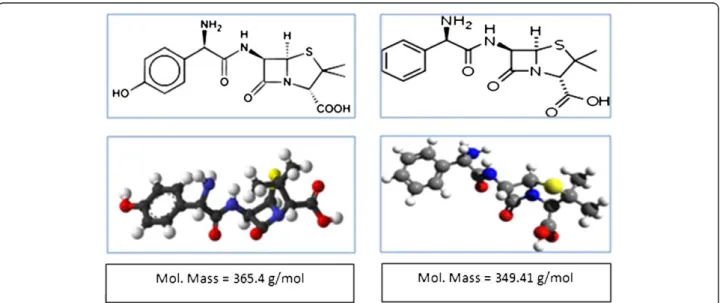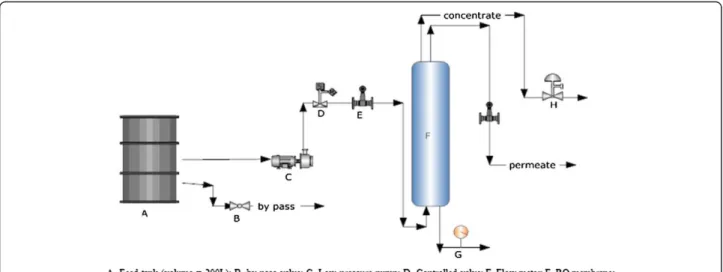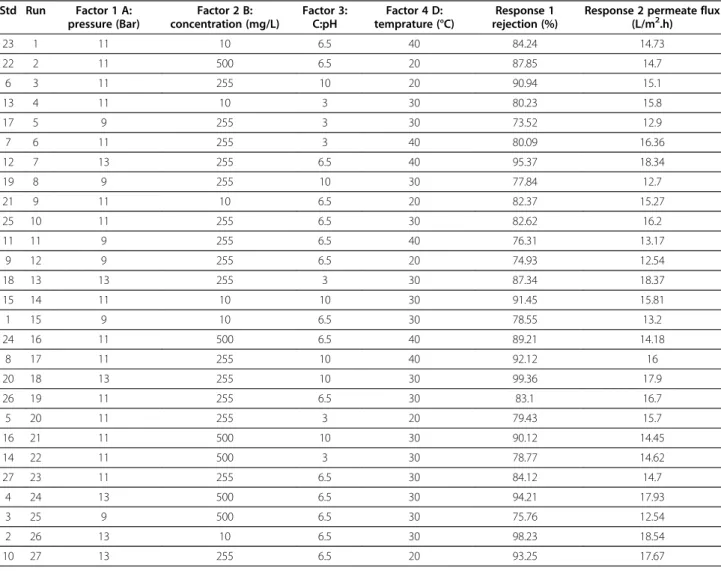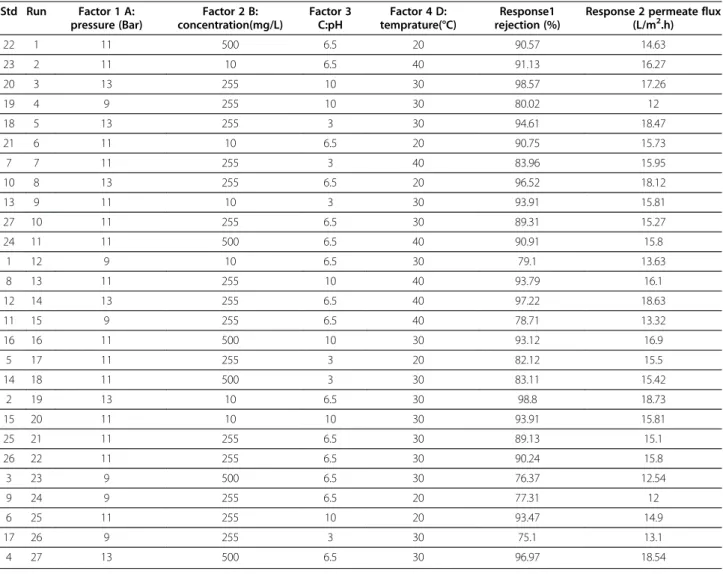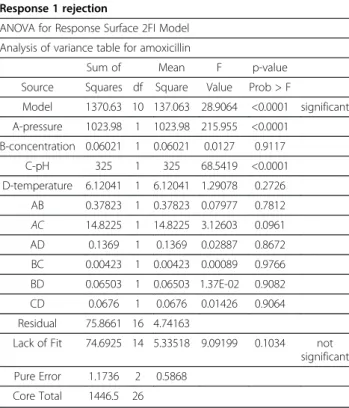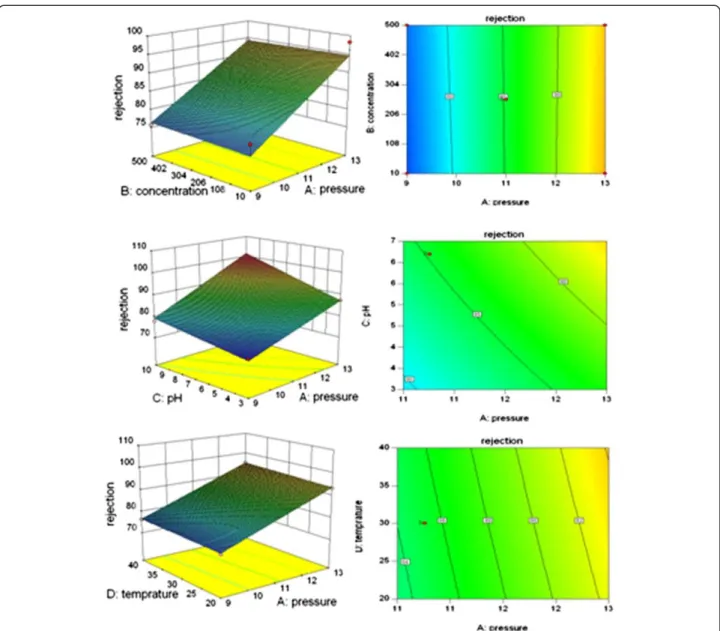R E S E A R C H A R T I C L E
Open Access
Performance evaluation of reverse osmosis
technology for selected antibiotics removal from
synthetic pharmaceutical wastewater
Mitra Gholami
1, Roya Mirzaei
1*, Roshanak Rezaei Kalantary
1, Ahmad Sabzali
2and Fateme Gatei
1Abstract
This study addresses the possibility for low pressure reverse osmosis membrane (RE 2521, CSM) process to serve as an alternative to remove selected antibiotics (ampicillin and amoxicillin) from synthetic wastewater by changing operating conditions such as pH = 3, 6.5 and 10; Pressure = 9, 11 and13 (bar); antibiotic concentration = 10, 255 and 500(mg/L), and temperature = 20, 30 and 40°C. The experiment was designed based on Box-benken, which is a Response Surface methodology design (RSM), using Design Expert software. The concentration of antibiotics was measured by applying a UV-spectrophotometer (Cecil), at the wavelength of 254 nm. Results showed a range of rejection percentage from 73.52% to 99.36% and 75.1% to 98.8%, for amoxicillin and ampicillin, respectively. Considering the solute rejections and the membrane porosity show that the prevailing rejection mechanism of the examined antibiotics by the membrane was the size exclusion effect. The permeate flux for both of the antibiotics was 12–18.73 L/m
2
.h. Although the permeate flux and antibiotic rejection are influenced by operating pressure, pH, and temperature individually, the interaction between operating parameters did not have noticeable effects. According to the results obtained in this study, the application of RO membrane is recommended for the selected antibiotics to be removed to a considerable degree (up to 95%).
Keywords:Amoxicillin, Ampicillin, Reverse osmosis (RO), Membrane technology, Pharmaceutical wastewater
Introduction
The effluents of Pharmaceutical industries are character-ized by high organic matter contents, toxicity, deep color, and high salt contents. Among all the pharmaceutical compounds that have environmental concern, antibiotics have an important role due to their high consumption rates in both veterinary and human medicine. Develop-ment of antibiotic resistant bacteria is the worst problem that may be created by the presence of antibiotics at low concentrations in the environment [1]. Antibiotics are persistent and bioaccumulative contaminants and bio-logically activecompounds which have been developed to have an effect on organisms; hence, they have the potential to negatively affect either aquatic or tellurian ecosystems, even in low concentrations in the range of
(μg–ng) per liter. In addition, antibiotics can also cause antibacterial resistance in microorganisms and be respon-sible for several allergenic responses [2-4].
Massive production of antibiotics started during World War II and so far, these compounds have been widely used in order to prevent and treat infectious diseases [4-7]. Although antibiotics have been used in large scale in the last fifty years, it was only in recent years that its occur-rence in the environment became a subject of scientific and public relevance [4,8,9]. Over the past few years, antibiotics have also been considered as emerging pollutants due to their continuous input and persistence in the aquatic eco-systems even at low concentrations. Residues of antibiotics are present in a diversity of environmental matrices, like surface and groundwater, hospital and WWTPs effluents, soils and sediments [4,10-12]. Several antibiotics such as ampicillin, erythromycin, sulphamethoxazole, tetracycline and penicilloyl groups are mainly released into the environ-ment by excretion (about 30–90%), reaching the wastewater * Correspondence:romina_r90@yahoo.com
1Depatment of Environmental Engineering, School of Public Health, Center
for Water Quality Research, Tehran University of Medical Sciences, Tehran, Iran
Full list of author information is available at the end of the article
treatment plants (WWTPs) where they are not completely removed, and contaminating natural waterways [9,13-15].
Amoxicillin and ampicillin are broad-spectrum b-lactam antibiotics that are semi-synthetic penicillin obtaining their antimicrobial properties from the presence of a beta-lactam ring [1].
They are commonly employed against infections caused by bacteria for human prescription medicine and as thera-peutic agents due to their broad spectrum against bacteria [14]. Results of toxicology studies have revealed that some antibiotics such as amoxicillin are suspected to have direct toxicity to certain aquatic organisms such as algae [16,17]. It is reported that photosynthesis mechanism of algae Synechocystis sp is inhibitated by the toxic effects of this compound [18]. Furthermore, this compound accumulates within single organism, (i.e. pathogenic bacteria) and increases its resistance leading to higher dosage needed or even its incapability to treat conventional diseases [14,19]. Amoxicillin has also been known to be hardly degradable, remaining as active compound within urine and feces [14,20]. In addition, its continued discharge through indus-trial route finally leads to irreversible change on wildlife and human beings [14,19].
Based on The very limited efficiency of conventional treatment plants such as sand filtration, chemical coagu-lation/flocculation and chlorination, in removing various organic micropollutants (OMPs) such as antibiotics, advanced technologies such as ozonation, advanced oxidation processes (AOPs) and activated carbon are considered to be more efficient in eliminating polar pharmaceuticals. In addition pressure-driven membrane processes, particularly nanofiltration (NF) and reverse osmosis (RO) have also been gaining attention in the
past decade and their application in drinking water treat-ment has been the focus of many researchers [21-23].
Regardless of the obvious advantages of using an RO membrane, which has been mostly used for desalination due to its ability to achieve high particulate rejection levels, it is suggested as an additional step in the sewage treatment process and it can be served as an absolute barrier to improve OMP removal. Several research groups have mentioned RO as the most promising and efficient technique for OMP removal [23-26].
The main contribution of this paper is to investigate the performance of a pilot scale RO membrane in rejection of selected antibiotics (ampicillin and amoxicillin) from a synthetic wastewater.
Materials and methods
In this study, two types of antibiotics- ampicillin and amoxicillin- which are the most produced with the highest rate consumed by Iranian pharmaceutical industry were considered. The chemical structure and molecular weights of amoxicillin and Ampicillin are shown in Figure 1.
The experiments were conducted using a cross flow spiral wound (RE2521) reverse osmosis membrane, supplied by CSM, a polyamide thin film composite mem-brane for operation at pH between 2 and 13 bar and temperature up to 40°C. The membrane characteristics are summarized in Table 1.
Chemicals were at least reagent grade and the highest purity commercially available. Both antibiotics were pur-chased from KOSAR pharmaceutical company in Iran. In order to prepare calibration curve, standard ampicillin and amoxicillin were supplied from Zigfride company, Germany. pH was adjusted with 1 mol/L NAOH and
sulfuric acid. All solutions were prepared with tap water. Determination of antibiotic residues was conducted by spectrophotometric method, previously reported [22,27-30].
Experimental setup
A pilot scale reverse-osmosis unit, schematically repre-sented in Figure 2, was designed to evaluate the perform-ance of the membrane. The membrane system unit was mainly comprised of a membrane module, pressure pump and a feed tank. Wastewater was pumped into the feed tank by means of a centrifugal high pressure pump, passing through the RO membrane.
The operating pressure over the membrane was varied from 9 to 13 bars, and the influent flow rate was changed from 0 to 8 L/min. Pressure and flow rates were set by manual valves.
The temperature was set at room temperature (20°C). The system was designed based on the hydraulic regime as the bench mark; therefore, there was no permeating or con-centrate recycling. Experiments were carried out at three levels of concentrations for each antibiotic. After obtaining
the optimum concentration, three different pressures at 20°C were studied. Also, the effect of pH and temperature on antibiotics removal efficiency was investigated. pH was adjusted by using sulfuric acid with normality of (1, 3) and sodium hydroxide with normality of (1, 3 and 6). The range of levels and variables are summarized in Table 2.
In all steps, samples were collected for analysis over a period of 2 hours [31].
Sample analysis
The Box-Benken statistical design based on response surface method (RSM) was applied to determine runs of samples and data analysis. Factorial analysis was carried out to determine the significant factors and interactions between the factors that can be affected by the perform-ance of RO membrane in terms of permeate flux and the antibiotic rejection. Through designing the experiments based on Box-benken, the investigation of the several factors affecting the efficiency of the system can be made possible. Simultaneous variation of the factors, rather than one at a time, can increase the efficiency of the experiment in terms of time and cost. Moreover, interactions between the factors can be easily studied in this way. Samples of permeate and raw wastewater were collected during experiments. Analytical approaches were based on the Standard Methods [32].
The concentration of the antibiotics was measured by means of a UV-spectrophotometer (CE-7400, Cecil) at the wavelength of 254 nm and pH was measured by HACH pH meter (HQ40d). Retention factor (R) of each compound and water flux was calculated by equations (1) and (2), respectively:
Table 1 Membrane characteristics
Membrane type
Type TFC(thin film composite)
Material PA (polyamide)
Charge Negative
Element
Configuration Spiral-wound, tapping
Size Diameter: 2.5 inch; Length: 21 inch
Effective Area 1.1 m2(12 ft2)
R¼ 1 CP CF
100 ð1Þ
Where R is the retention factor (%), Cp is the concen-tration in the permeate (mg/L) and CFis the concentra-tion in the raw soluconcentra-tion (mg/L) [33,34]
JW ¼ QP
A ð2Þ
Where Jwis the permeate flux (L/m2.h), QPis the per-meate flow per hour and A is active surface area of membrane (m2) [35,36]. The relationship between per-meate flux and operating pressure is based on equation (3) which was originally formulated by [37] as:
J¼A Pð ΔπÞ ð3Þ
Where J, A, P, and p are the permeate flux, the water permeation constant, the applied pressure and the os-motic pressure, respectively. Osos-motic pressure can be predicted by using the Van’t Hoff equation (4) as follows [38].
π¼ViCiRT ð4Þ
Where Vi, Ci, R, and T are the number of ions formed if the solute dissociates, the molar concentration of sol-ute, the gas constant, and the absolute temperature, respectively.
Table 2 Levels of experiments and range of operating parameters
Variables Level
Pressure (bar)
concentration (mg/L)
pH Temperature (°C)
1 9 10 3 20
2 11 255 6.5 30
3 13 500 10 40
Table 3 Experimental results of amoxicillin (with molecular weight of 365.4 g/mol) rejection by RO membrane conducted in different conditions and variables (all of runs are in block1)
Std Run Factor 1 A: pressure (Bar)
Factor 2 B: concentration (mg/L)
Factor 3: C:pH
Factor 4 D: temprature (°C)
Response 1 rejection (%)
Response 2 permeate flux (L/m2.h)
23 1 11 10 6.5 40 84.24 14.73
22 2 11 500 6.5 20 87.85 14.7
6 3 11 255 10 20 90.94 15.1
13 4 11 10 3 30 80.23 15.8
17 5 9 255 3 30 73.52 12.9
7 6 11 255 3 40 80.09 16.36
12 7 13 255 6.5 40 95.37 18.34
19 8 9 255 10 30 77.84 12.7
21 9 11 10 6.5 20 82.37 15.27
25 10 11 255 6.5 30 82.62 16.2
11 11 9 255 6.5 40 76.31 13.17
9 12 9 255 6.5 20 74.93 12.54
18 13 13 255 3 30 87.34 18.37
15 14 11 10 10 30 91.45 15.81
1 15 9 10 6.5 30 78.55 13.2
24 16 11 500 6.5 40 89.21 14.18
8 17 11 255 10 40 92.12 16
20 18 13 255 10 30 99.36 17.9
26 19 11 255 6.5 30 83.1 16.7
5 20 11 255 3 20 79.43 15.7
16 21 11 500 10 30 90.12 14.45
14 22 11 500 3 30 78.77 14.62
27 23 11 255 6.5 30 84.12 14.7
4 24 13 500 6.5 30 94.21 17.93
3 25 9 500 6.5 30 75.76 12.54
2 26 13 10 6.5 30 98.23 18.54
Results
The results of performance reverse osmosis membrane for removal of selected antibiotics (ampicilin and amoxicillin) samples are shown in Tables 3 and 4. As can be seen, the variations of rejection and permeate flux are greatly influ-enced by parameters such as pH and operating pressure. The results were analyzed through factorial analysis, based on Design Expert Software.
From the results in Tables 3 and 4, the rejection and permeate flux by RO membrane varied between 73.52% to 99.36% and 12.7 to 18.5 (L/m2.h) for amoxicillin and 75.1% to 98.8% and 12 to 18.73 (L/m2.h) for ampicillin, respectively.
As can be seen in Table 3, the effect of trans-membrane operating pressure on selected antibiotics’ rejection was much more than that of pH (76% to 96% for pressure increasing from 9 to 13 bar and 80% to 90% for pH of 3 to
10). It can also be seen that the effect of concentration and temperature on the rejection was by no means no-ticeable. The analysis of variance (ANOVA) for rejection and permeate flux of both antibiotics are shown in Tables 5 and 6, respectively. These results indicate the significance of the main operating parameters and their interaction effects based on p-value (at P < 0.05 level of significance).
The permeate flux decreased slightly as concentration was increased from 10 to 500 mg/L. According to ANOVA results for both of antibiotics’ permeate flux show that operating pressure and concentration have significant effect on permeate flux, based on P<0.0001 for pressure and P<0.04 for concentration. It can be concluded that pressure has a significant influence (more than 90 percent). The effect of pH and temperature on permeate flux were negligible.
Table 4 Experimental results of ampicillin (with molecular weight of 349.41g/mol) rejection by RO membrane conducted in different conditions and variables (all of runs are in block1)
Std Run Factor 1 A: pressure (Bar)
Factor 2 B: concentration(mg/L)
Factor 3 C:pH
Factor 4 D: temprature(°C)
Response1 rejection (%)
Response 2 permeate flux (L/m2.h)
22 1 11 500 6.5 20 90.57 14.63
23 2 11 10 6.5 40 91.13 16.27
20 3 13 255 10 30 98.57 17.26
19 4 9 255 10 30 80.02 12
18 5 13 255 3 30 94.61 18.47
21 6 11 10 6.5 20 90.75 15.73
7 7 11 255 3 40 83.96 15.95
10 8 13 255 6.5 20 96.52 18.12
13 9 11 10 3 30 93.91 15.81
27 10 11 255 6.5 30 89.31 15.27
24 11 11 500 6.5 40 90.91 15.8
1 12 9 10 6.5 30 79.1 13.63
8 13 11 255 10 40 93.79 16.1
12 14 13 255 6.5 40 97.22 18.63
11 15 9 255 6.5 40 78.71 13.32
16 16 11 500 10 30 93.12 16.9
5 17 11 255 3 20 82.12 15.5
14 18 11 500 3 30 83.11 15.42
2 19 13 10 6.5 30 98.8 18.73
15 20 11 10 10 30 93.91 15.81
25 21 11 255 6.5 30 89.13 15.1
26 22 11 255 6.5 30 90.24 15.8
3 23 9 500 6.5 30 76.37 12.54
9 24 9 255 6.5 20 77.31 12
6 25 11 255 10 20 93.47 14.9
17 26 9 255 3 30 75.1 13.1
The interactions among the parameters on the amoxi-cillin rejection and permeate flux in three-dimensional surface plots and two dimensional contour plots are shown in Figures 3 and 4.
Discussion
Based on the results, removal efficiency increased with mo-lecular weights of the antibiotics compounds. The best rejection was obtained for amoxicillin (99.36%), which has a higher molecular weight than ampicillin (365.4 g/mol). There is a consensus that nonionazable organic solutes with molecular weights between 200 and 400 g/mol are efficiently rejected by RO/NF membranes [39,40].
The results showed that an increase in pressure from 9 to 13 bar would lead the flux to increase as well, which was due to the solution-diffusion model. Also, the condensed membrane increases the static resistance and then more solutes are rejected [41]. On the other hand, flux under the experimental conditions is also a function of salt retention, as the retained ions accumulate in the boundary layer of the membrane where the concentration polarization effect imposes an osmotic pressure and reduces the effective driving force across the membrane [42]. By increasing feed pressure, the driving force will increase and the overcome membrane resistance [33,38,43,44]. In this study, increasing
the pressure from 9 to 13 bar led to an increase in the per-meate flux and rejection. Higher flux values were obtained at 13 bar for applied amoxicillin and ampicillin (18.54 L/m2.h); (Tables 3 and 4 for amoxicillin and ampicillin, respectively).
With respect to the experimental conditions used in this study, the P-value (< 0.001) showed that the pressure and pH have significant effects on the rejection of amoxicillin and ampicillin individually, but all interaction effects among the operating parameters in this study were insig-nificant for selected antibiotic rejection. As presented in Tables (5 and 6), P-values for all interactions were higher than 0.05.
Retention of organic pollutants in membrane separ-ation processes depends on the characteristics of both membrane and the pollutants [45]. In addition, most of the papers reviewed by Bellona et al. have shown that the transport of uncharged organic compounds through reverse osmosis (RO) membrane is controlled mainly by the sieving mechanism [46]. However, the rejection of the uncharged organic by RO/NF membranes is often affected by physio-chemical properties of the system, and in the case of ionized organics, the charge exclusion plays a significant role in the rejection process [38,39]. The sieving mechanism of solute rejection is dependent on the relation between the size of solute molecules and the size of the membrane pores. An RO membrane has a very small molecular weight cut-off (MWCO) and it can retain a
Table 5 ANOVA for amoxicillin rejection and interaction effects of parameters
Response 1 rejection
ANOVA for Response Surface 2FI Model
Analysis of variance table for amoxicillin
Sum of Mean F p-value
Source Squares df Square Value Prob > F
Model 1370.63 10 137.063 28.9064 <0.0001 significant
A-pressure 1023.98 1 1023.98 215.955 <0.0001
B-concentration 0.06021 1 0.06021 0.0127 0.9117
C-pH 325 1 325 68.5419 <0.0001
D-temperature 6.12041 1 6.12041 1.29078 0.2726
AB 0.37823 1 0.37823 0.07977 0.7812
AC 14.8225 1 14.8225 3.12603 0.0961
AD 0.1369 1 0.1369 0.02887 0.8672
BC 0.00423 1 0.00423 0.00089 0.9766
BD 0.06503 1 0.06503 1.37E-02 0.9082
CD 0.0676 1 0.0676 0.01426 0.9064
Residual 75.8661 16 4.74163
Lack of Fit 74.6925 14 5.33518 9.09199 0.1034 not significant
Pure Error 1.1736 2 0.5868
Core Total 1446.5 26
Table 6 ANOVA for ampicillin rejection and interaction effects of parameters
Response 1 rejection%
ANOVA for Response Surface 2FI Model
Analysis of variance table for ampicillin
Sum of Mean F p-value
Source Squares df Square Value Prob > F
Model 1307.76 10 130.776 20.2892 < 0.0001 significant
A-pressure 1122.88 1 1122.88 174.209 < 0.0001
B-concentration 22.8252 1 22.8252 3.54122 0.0782
C-pH 133.8 1 133.8 20.7585 0.0003
D-temprature 2.0667 1 2.0667 0.32064 0.5791
AB 0.2025 1 0.2025 0.03142 0.8615
AC 0.2304 1 0.2304 0.03575 0.8524
AD 0.1225 1 0.1225 0.01901 0.8921
BC 25.05 1 25.05 3.88639 0.0662
BD 0.0004 1 0.0004 6.21E-05 0.9938
CD 0.5776 1 0.5776 0.08961 0.7685
Residual 103.129 16 6.44558
Lack of Fit 102.42 14 7.31568 20.6134 0.0472 significant
Pure Error 0.7098 2 0.3549
large fraction of low molecular weight compounds (e.g. amino acids or sugars). As pointed out by kimura et al, negatively charged compounds would be significantly rejected by NF/RO membranes due to the electrostatic re-pulsion between the compounds and membranes, even compounds with a small molecular weight (e.g. 110) and a rather loose membrane (i.e. NF) [38,47]. Therefore, mo-lecular weight is one of the most important factors in anti-biotic removal by RO membrane.
According to the obtained results, the degree to which the antibiotics were rejected increased as pH incresed. The phenomenon can be explained through the charged membrane and the charged solute which leads to a Donnan potential. Zeta potential of the membrane had a
negative charge as the absolute zeta potential value decreased towards acidic pH values. This charge vari-ation as a function of pH is due to the dissocivari-ation of membrane functional groups such as carboxylic and amide, and adsorption of hydroxide ion. All those effects were influenced by the pH of solution [48]. With respect to the chemical structure of antibiotics, acidic pH leads to the production of negative charged ions of antibiotics. The charged membrane attracts opposite charged ions to achieve equilibrium. At the same time, the membrane will repel the same charged ions by an electrostatic force. In addition, the opposite charged ions will also be rejected due to electorneutrality in the solution. Because of these interactions, the water can pass through the
membrane. This mechanism enhances the rejection of antibiotics due to the charges of pH, causing the mem-brane to be charged [38].
Although the increase in the feed concentration had no effect on antibiotic rejection, permeate flux decreased slightly. It is known that when concentration increases, osmosis pressure will increase as well, decreasing the effective operating pressure. At the same time, the viscosity of solution will increase, leading the flux to decrease [41].
Based on Figures 3 and 4, the distribution of contours suggested that all of the parameters were quite independent of each and that the interactions between all of the parameters (pressure, concentration, pH, and
temperature) were insignificant to the antibiotics rejection and permeates flux. Since the results obtained from experiments carried out on ampicillin were the same as those conducted on amoxicillin, repetitive results were omitted.
Competing interests
The authors declare that they have no competing interests.
Authors’contributions
Mitra Gholami, Roya Mirzaei, Roshanak Rezaei Kalantary, Ahmad Sabzali and Fateme Gatei carried out the article with the title of: Performance evaluation of reverse osmosis technology for selected antibiotics removal from synthetic pharmaceutical wastewater, participated in the sequence alignment and drafted the manuscript. All authors read and approved the final manuscript.
Acknowledgements
This research was conducted with funding from the vice chancellor for research of Tehran University of medical sciences (Grant No. 751).
Author details
1Depatment of Environmental Engineering, School of Public Health, Center
for Water Quality Research, Tehran University of Medical Sciences, Tehran, Iran.2Department of Environmental Health Engineering, School of Public Health, Isfahan University of Medical Sciences, Isfahan, Iran.
Received: 1 December 2012 Accepted: 1 December 2012 Published: 10 December 2012
References
1. Elmolla E, Chaudhuri M:Optimization of Fenton process for treatment of amoxicillin, ampicillin and cloxacillin antibiotics in aqueous solution.
J Hazard Mater2009,170:666–672.
2. Bound JP, Voulvoulis N:Predicted and measured concentrations for selected pharmaceuticals in UK rivers: implications for risk assessment.
Water Res2006,40:2885–2892.
3. Díaz-Cruz MS, García-Galán MJ, Barceló D:Highly sensitive simultaneous determination of sulfonamide antibiotics and one metabolite in environmental waters by liquid chromatography–quadrupole linear ion trap–mass spectrometry.J Chromatogr A2008,1193:50–59.
4. Homem V, Alves A, Santos L:Amoxicillin degradation at ppb levels by Fenton's oxidation using design of experiments Science of the Total Environment.Sci Total Environ2010,408:6272–6280.
5. Lee H, Shoda M:Removal of COD and color from livestock wastewater by Fenton method.J Hazard Mater2008,153:1314–1319.
6. Kümmerer K:Antibiotics in the aquatic environment—a review–Part I.
Chemosphere2009,75:417–434.
7. Martinez JL:Environmental pollution by antibiotics and by antibiotic resistance determinants.Environ Pollut2009,157:2893–2902.
8. Ginebreda A, Muñoz I, López De Alda M, Brix R, López-Doval J, Barceló D:
Environmental risk assessment of pharmaceuticals in rivers: relationships between hazard indexes and aquatic macroinvertebrate diversity indexes in the Llobregat River (NE Spain).Environ Int2010,36:153–162.
9. Hernando MD, Mezcua M, Fernández-Alba AR, Barceló D:Environmental risk assessment of pharmaceutical residues in wastewater effluents, surface waters and sediments.Talanta2006,69:334–342.
10. Benito-Peña E, Partal-Rodera AI, León-González ME, Moreno-Bondi MC:
Evaluation of mixed mode solid phase extraction cartridges for the preconcentration of betalactam antibiotics in wastewater using liquid chromatography with UV-DAD detection.Anal Chim Acta2006,
556:415–422.
11. Batt AL, Kim S, Aga DS:Comparison of the occurrence of antibiotics in four full-scale wastewater treatment plants with varying designs and operations.Chemosphere2008,68:428–435.
12. Watkinson AJ, Murby EJ, Kolpin DW, Costanzo SD:The occurrence of antibiotics in an urban watershed: From wastewater to drinking water.
Sci Total Environ2009,407:2711–2723.
13. Ding J, Ren N, Chen L, Ding L:On-line coupling of solid-phase extraction to liquid chromatography–tandem mass spectrometry for the determination of macrolide antibiotics in environmental water.
Anal Chim Acta2009,634:215–221.
14. Kristia Putraa E, Pranowoa R, Sunarsob J, Indraswatia N, Ismadjia S:
Performance of activated carbon and bentonite for adsorption of amoxicillin from wastewater: Mechanisms, isotherms and kinetics.
Water Res2009,43:2419–2430.
15. Chen L, Zhang X, Xu Y, Du X, Sun X, Sun L:Determination of fluoroquinolone antibiotics in environmental water samples based on magnetic molecularly imprinted polymer extraction followed by liquid chromatography–tandem mass spectrometry.Anal Chim Acta2010, 662:31–38.
16. Grung M, Kallqvist T, Sakshaug S, Skurtveit S, Thomas KV:Environmental assessment of Norwegian priority pharmaceuticals based on the EMEA guideline.Ecotoxicol Environ Saf2008,712:328–340.
17. Sui Q, Huang J, Deng S, Yu G, Fan Q:Occurrence and removal of pharmaceuticals, caffeine and DEET in wastewater treatment plants of Beijing.China Water Research2010,44:417–426.
18. Pan X, Deng C, Zhang D, Wang J, Mu G, Chen Y:Toxic effects of amoxicillin on the photosystem II of Synechocystis sp. characterized by a variety of in vivo chlorophyll fluorescence tests.Aquat Toxicol2008,
89:207–213.
19. Aksu Z, Tunc O:Application of biosorption for penicillin G removal: comparison with activated carbon.Process Biochem2005,40:831–847.
20. Jara CC, Fino D, Specchia V, Saracco G, Spinelli P:Electrochemical removal of antibiotic from wastewaters, Applied Catalyst B.Environmental2007,
70:479–487.
21. Radjenovića J, Petrovića M, Venturac F, Barcelóa D:Rejection of
pharmaceuticals in nanofiltration and reverse osmosis membrane drinking water treatment.Water Res2008,42:3601–3610.
22. Le-Minh N, Coleman HM, Khan SJ, Van Luer Y, Trang TTT, Watkins G, Stuetz RM:The application of membrane bioreactors as decentralised systems for removal of endocrine disrupting chemicals and pharmaceuticals.
Water Sci Technol2010,61:1081–1088.
23. Sahar E, David I, Gelman Y, Chikurel H, Aharoni A, Messalem R, Brenner A:
the use of RO to remove emerging micropollutants following CAS/UF or MBR treatment of municipal wastewater.Desalination2011,273:142–147.
24. Khan IA, Spalding RF:Enhanced in situ denitrification for a municipal well.
Water Res2004,38:3382–3388.
25. Wintgens T, Gallenkemper M, Melin T:Removal of endocrine disrupting compounds with membrane processes in wastewater treatment and reuse.Water Sci Technol2004,50:1–8.
26. Snyder SA, Adham S, Redding AM, Cannon FS, De Carolis J, Oppenheimer J, Wert EC, Yoon Y:Role of membranes and activated carbon in the removal of endocrine disruptors and pharmaceuticals.Desalination2007,
202:156–181.
27. Choi KJ, Kim SG, Kim CW, Kim SH:Determination of antibiotic compounds in water by on-line SPE-LC/MSD.Chemosphere2007,66:977–984.
28. Li JD, Cai YQ, Shi YL, Mou SF, Jiang GB:Determination of sulfonamide compounds in sewage and river by mixed hemimicelles solid-phase extraction prior to liquid chromatography-spectrophotometry.
J Chromatogr A2007,1139:178–184.
29. Peng X, Tan J, Tang C, Yu Y, Wangt Z:Multiresidue determination of fluoroquinolone, sulfonamide, trimethoprim, and chloramphenicol antibiotics in urban waters in China.Environ Toxicol Chem2008,
27:73–79.
30. Esponda SM, Padron MET, Ferrera ZS, Rodriguez JJS:Solid-phase microextraction with micellar desorption and HPLC-fluorescence detection for the analysis of fluoroquinolones residues in water samples.
Anal Bioanal Chem2009,394:927–935.
31. Koyuncu I, Topacik D:Effects of organic ion on the separation of salts by nanofiltration membranes.J Membr Sci2002,195:247–263.
32. APHA:Standard methods for the examination of water and waste water. 20th edition. Washington DC, USA: American public health association/American water works association, and Water Environment Federation; 1998. 33. Gholami M, Nasseri S, Alizadehzadeh M:Textile dye removal by membrane
technology and biological oxidation.Water Qual Res J Can2003,
38:379–391.
34. Moulin P, Allergre C, Maisseu M, Charbit F:Saving and re-use of salts and water present in dye house effluents.Desalination2004,162:13–22.
35. Ahmad AL, Puasa SW, Zulkali MMD:Micellar-enhanced ultrafiltration for removal of reactive dyes from an aqueous solution.Desalination2006,
191:153–161.
36. Hassani AH, Mirzaye R, Nasseri S, Borghei M, Gholami M, Torabifar B:
Nanofiltration process on dye removal from simulated textile wastewater.Int J Environ Sci Tech2008,5:401–408.
37. Lonsdale H, Merten U, Riley R:Transport properties of cellulose acetate osmotic membrane.Appl Polym Sci1965,9:1341.
38. Razak ARA, Ujang Z, Ozaki H:Removal of endocrine disrupting chemicals (EDCs) using low pressure reverse osmosis membrane (LPROM).Water Sci Technol2007,56:161–168.
39. Kosutic K, Dolar D, Asperger D, Kunst B:Removal of antibiotics from a model wastewater by RO/NF membranes.Sep Purif Technol2007,
53:244–249.
40. Koyuncua I, Arikana OA, Wiesnerc MR, Riceb C:Removal of hormones and antibiotics by nanofiltration membranes.J Membr Sci2007,309:94–101.
41. Zhua A, Zhua W, Wub Z, Jingb Y:Recovery of clindamycin from fermentation wastewater with nanofiltration membranes.Water Res2003,
42. Schäfer AI, Nghiem LD, Waite TD:Removal of the natural hormone Estrone from aqueous solutions using nanofiltration and reverse osmosis.Environ Sci Technol2003,37:182–188.
43. Ujang Z, Anderson GK:Performance of low pressure reverse osmosis membrane (LPROM) for seperating mono- and divalent ions.Water Sci Tech1998,38:521–528.
44. Chen V, Tang C:Nanofiltration of textile wastewater for water reuse.
Desalination2002,143:11–20.
45. Ozaki H, Ikejima N, Matsui S:Proceedings of the fourth seminar on water and wastewater management and technologies, JSPS-VCC core university program
‘environmental Science’(11–13 July 2006), the pulai desaru beach resort. Johor, Malaysia: Kota Tinggi; 2006.
46. Bellona C, Drewes JE, Xu P, Amy G:Factors affecting the rejection of organic solutes during NF/RO treatment–a literature review.Water Res
2004,38:2795–2809.
47. Kimura K, Amy G, Drewes JE, Heberer T, Kim T, Watanabe Y:Rejection of organic micropollutants (disinfections by-products, endocrine disrupting compounds, and pharmaceutically active compounds) by NF/RO membranes.J Membr Sci2003,227:113–121.
48. Childress AE, Elimelech M:Relating nanofiltration membrane performance to membrane charge (electrokinetic) characteristics.Environ Sci Tech
2000,34:3710–3716.
doi:10.1186/1735-2746-9-19
Cite this article as:Gholamiet al.:Performance evaluation of reverse osmosis technology for selected antibiotics removal from synthetic pharmaceutical wastewater.Iranian Journal of Environmental Health Sciences & Engineering20129:19.
Submit your next manuscript to BioMed Central and take full advantage of:
• Convenient online submission
• Thorough peer review
• No space constraints or color figure charges
• Immediate publication on acceptance
• Inclusion in PubMed, CAS, Scopus and Google Scholar
• Research which is freely available for redistribution
